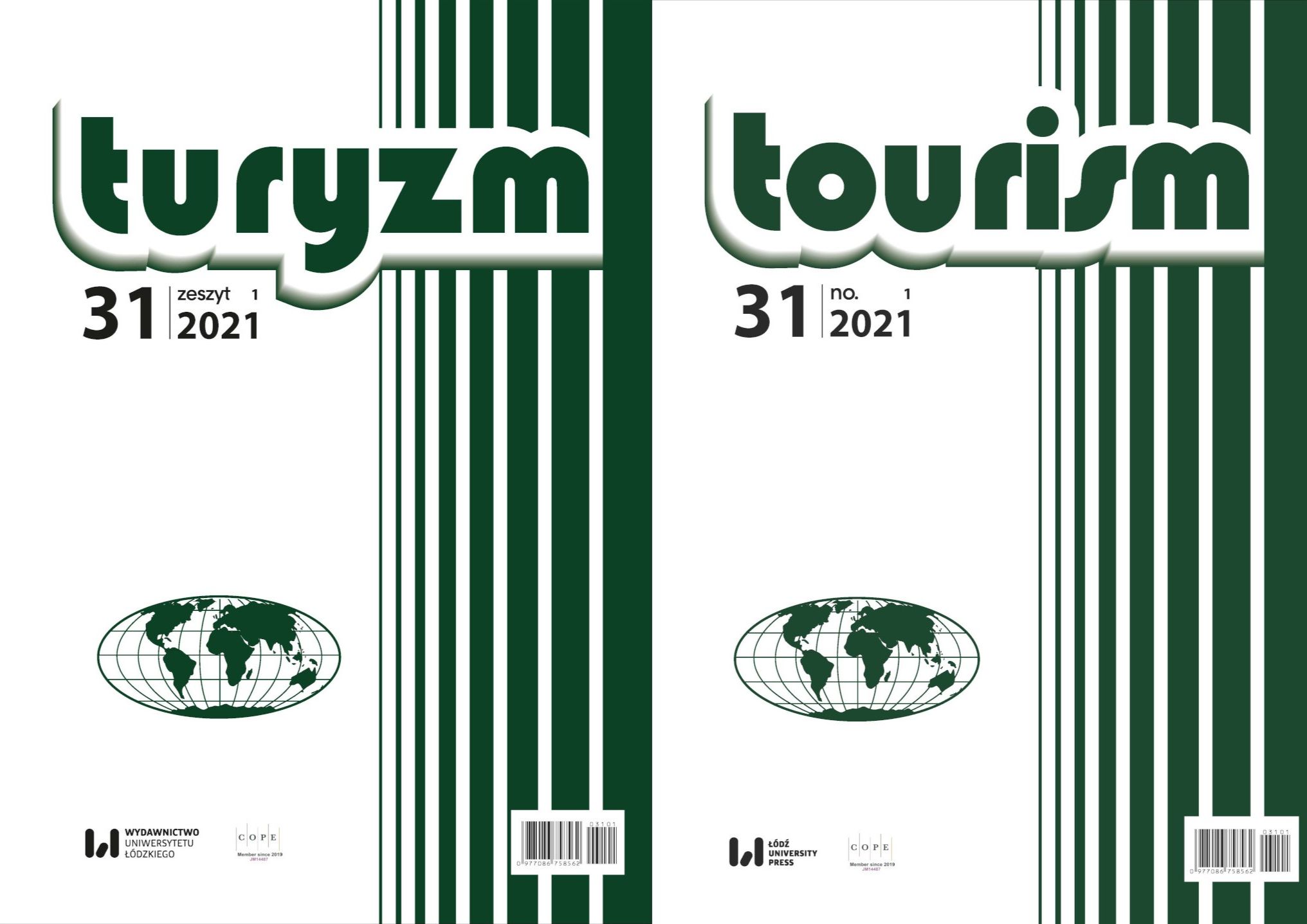A cluster approach to the formation of tourism destinations in Western Ukrainian cross-border regions
DOI:
https://doi.org/10.18778/0867-5856.31.1.15Keywords:
cluster, approach, cross-border regions, tourism destinations, formation of destinationsAbstract
The research aims at exploring western Ukrainian cross-border regions where many natural recreational resources, historical, cultural and architectural monuments, a developed transport infrastructure, strong ethnic ties and wide opportunities for tourism flows from the cross-border regions of neighboring countries are found. To achieve this goal, the authors studied foreign experience, in particular the processes of the creation and operation of clusters in Romania and Poland which helped to identify certain stages of development of tourism destinations based on a cluster approach. Comparison of the activities of already established tourism clusters in Ukraine and abroad has helped to establish a list of major business structures that might become a part of a cluster and be involved in the formation of a tourism destination. Based on an analysis of natural and recreational potential, and cultural and historical heritage in western Ukrainian cross-border regions, possible profiles of tourism destinations, and the interest of tourist and other enterprises to be brought together into tourism clusters, are determined, and this has been confirmed by a survey
Downloads
References
Algieri, B., Aquino, A., Succurro, M. (2018). International competitive advantages in tourism: An eclectic view. Tourism Management Perspectives, 25, 41–52. https://doi.org/10.1016/j.tmp.2017.11.003
Google Scholar
DOI: https://doi.org/10.1016/j.tmp.2017.11.003
Bellini, N., Grillo, F., Lazzeri, G., Pasquinelli, C. (2017). Tourism and regional economic resilience from a policy perspective: Lessons from smart specialization strategies in Europe. Journal European Planning Studies, 25 (1), 140–153. https://doi.org/10.1080/09654313.2016.1273323
Google Scholar
DOI: https://doi.org/10.1080/09654313.2016.1273323
Beltramo, R., Rostagno, A., Bonadonna, A. (2018). Land consolidation associations and the management of territories in harsh Italian environments: A review. Resources, 7. Retrieved from: https://www.mdpi.com/2079-9276/7/1/19 (15.07.2020). https://doi.org/10.3390/resources7010019
Google Scholar
DOI: https://doi.org/10.3390/resources7010019
Benner, M. (2017). From clusters to smart specialization: Tourism in institution-sensitive regional development policies. Economies, 5 (3), 26. https://doi.org/10.3390/economies5030026
Google Scholar
DOI: https://doi.org/10.3390/economies5030026
Bobrovska, O.Y., Krushelnytska, T.A., Latinin, M.A., Lypovska, N.A., Dreshpak, V.M. (2017). Potentsial rozvytku terytoriy: metodolohichni zasady formuvannya i naroshchennya [Potential of territorial development: methodological principles of formation and increase]. Dnipro: DRIDU NADU [in Ukrainian].
Google Scholar
Carpathian Tourism Cluster Romania (2020). Tourism-cluster-romania.com. Retrieved from: http://tourism-cluster-romania.com/tourism-region/carpathian-mountains (23.07.2020).
Google Scholar
Chernivetsʹka ODA vyznachyla shistʹ «turystychnykh mahnitiv» Bukovyny [Chernivtsi Regional State Administration has identified six “tourism magnets” of Bukovina] (2020). Molbuk.ua. Retrieved from: https://molbuk.ua/chernovtsy_news/202752-chernivecka-oda-vyznachyla-6-turystychnykh-magnitiv-bukovyny.html (12.08.2020).
Google Scholar
Clusterul Medical Sanatate Romania [Romania Health Medical Cluster] (2020). Sanatateromania.ro. Retrieved from: https://www.sanatateromania.ro/prezentare [in Romanian] (23.07.2020).
Google Scholar
Gerasymenko, V. (ed.) (2016). Otsinka turystychno-rekreatsiynoho potentsialu rehionu [Assessment of tourism and recreational potential of the region]. Odessa: ONEU [in Ukrainian].
Google Scholar
Korzh, N.V., Basyuk D.I. (2017). Upravlinnya turystychnymy destynatsiyamy [Management of tourism destinations]. Winnica: «PP «TD Edelʹveys i K» [in Ukrainian].
Google Scholar
Kravtsiv, V.S. (ed.). (2015). Rozvytok transkordonnoho spivrobitnytstva: naukovo-analitychna dopovidʹ [Development of cross-border cooperation: academic and analytical report]. Lviv: DU «Instytut rehionalʹnykh doslidzhenʹ imeni M.I. Dolishnʹoho NAN Ukrayiny» [in Ukrainian].
Google Scholar
Kusa, R., Peszko, A. (2020). Małopolski klaster turystyczny – perspektywy rozwoju w świetle badań własnych. Zarz.agh.edu.pl. Retrieved from: http://www.zarz.agh.edu.pl/rKusa/ZZ_P19_06'%20MalopolskiKlasterTurystyczny.pdf (13.06.2020).
Google Scholar
Mazaraki, A.A. (ed.) (2019). Ukraine and the world: The tourism system. Prague: Eatern European Center of the Fundamental Researchers (EECFR).
Google Scholar
Mazur, F. (2005). Sotsialʹno-ekonomichni umovy rozvytku rekreatsiynoyi industriyi (na prykladi Karpat·sʹkoho rehionu) [Socio-economic conditions for the development of the recreational industry (on the example of the Carpathian region)]. Kyiv: Tsentr Uchbovoyi Literatury [in Ukrainian].
Google Scholar
Melnik, A.F. (2018). Upravlinnya resursamy terytoriyi v konteksti yevropeysʹkoyi ta natsionalʹnoyi polityky rehionalʹnoho rozvytku [Territory resource management in the context of European and national regional development policy]. Visnyk Ternopilʹsʹkoho natsionalʹnoho ekonomichnoho universytetu – The Herald of Ternopil National Economic University, 3, 7–22 [in Ukrainian]. https://doi.org/10.35774/visnyk2018.03.007
Google Scholar
DOI: https://doi.org/10.35774/visnyk2018.03.007
Mikula, N., Matvyeyev, Y., Tymechko, I. (2014). Specific features of organization of new cross-border cooperation forms. In: R. Fedan, B. Petrecka, S. Dyrda-Maciałek (eds), Problemy współczesnej Europy – ujecie interdyscyplinarne (pp. 31–38). Jarosław: Wydawnictwo Państwowej Wyższej Szkoły Techniczno-Ekonomicznej im. ks. Bronisława Markiewicza.
Google Scholar
Na Lvivshchyni zyavyvsya novyy turystychnyy klaster «Lvivske Opillya» [A new tourism cluster “Lvivske Opillya” has appeared in Lviv region] (2020). Decentralization.gov.ua. Retrieved from: https://decentralization.gov.ua/news/12162 (14.09.2020).
Google Scholar
Naumanen, M. (2019). European panorama of clusters and industrial change: Emerging industries: Driving strength in 10 cross-sectoral industries. European Commission EC. Retrieved from: https://cris.vtt.fi/en/publications/european-panorama-of-clusters-and-industrial-change-emerging-indu (20.01.2021).
Google Scholar
Novelli, M., Schmitz, B., Spencer, T. (2006). Networks, clusters and innovation in tourism: A UK experience. Tourism Management, 27, 1141–1152. https://doi.org/10.1016/j.tourman.2005.11.011
Google Scholar
DOI: https://doi.org/10.1016/j.tourman.2005.11.011
Odinokova, T. (2019). Tourism cluster as a form of innovation activity. Economics. Ecology. Socium, 3 (2), 1–11. https://doi.org/10.31520/2616-7107/2019.3.2-1
Google Scholar
DOI: https://doi.org/10.31520/2616-7107/2019.3.2-1
Oteshova, A.K., Niyazbayeva, A.A., Prodanova, N.A., Patutina, N.A., Moshkin, A.S., Sabirova, R.K. (2020). Investment bases for the development of clusters at the regional level. Talent, Development & Excellence, 12 (2), 768–775.
Google Scholar
Polyvach, K.A. (2012). Kul’turna spadshchyna ta yiyi vplyv na rozvytok rehioniv Ukrayiny [Cultural heritage and its influence on the development of regions of Ukraine]. Kyiv: Institute of Geography, NAS of Ukraine [in Ukrainian].
Google Scholar
Porter, M. (2005). Konkurentsyya [Competition]. Moscow: Izdatel’skiy dom «Vil’yams» [in Russian].
Google Scholar
Porter, M. (2016). Konkurentnaya strategiya: Metodika analiza otrasley i konkurentov [Competitive strategy: a methodology for analyzing industries and competitors]. Moscow: Alpina Publisher [in Russian].
Google Scholar
Przemyśl – klaster turystyczny [Przemyśl – tourism cluster] (2020). Miasta.pl. Retrieved from: http://www.miasta.pl/aktualnosci/przemysl-klaster-turystyczny (22.10.2020).
Google Scholar
Residence of Bukovinian and Dalmatian Metropolitans (2020). Whc. unesco.org. Retrieved from: http://whc.unesco.org/en/list/1330 (4.09.2020).
Google Scholar
Roman, M. (2013). Klastry jako forma współdziałania w działalności turystycznej. Zarządzanie i Finanse, 1 (3), 309–320.
Google Scholar
Rudenko, V.P., Rudenko, S.V., Pidhirna, V.N., Tsependa, M.V., Yachnyuk, M.O., Vatseba, V.Y., Danilova, O.M., Hrytsku, V.S., Tsependa, M.M., Palamaryuk, M.Y., Chubrey, O. S., Yemchak, T.V., Rybchuk, Y.O., Kibych, I.V., Nakonechnyy, K.P., Burka, V.Y. (2019). Menedzhment turystychnoyi industriyi [Management of the tourism industry]. Chernivtsi: CHNU: Ruta [in Ukrainian].
Google Scholar
Situatia clusterelor din Romania. Rezumat. Aprilie 2020 [Cluster situation in Romania. Summary. April 2020] (2020). Clustero. eu. Retrieved from: http://clustero.eu/wp-content/uploads/2020/04/situatia-clusterelor-din-romania-aprilie-2020.pdf [in Romanian] (29.08.2020).
Google Scholar
Stasiak, A. (2007). Klaster turystyczny – nowe wyzwanie dla ROT-ów i LOT-ów? Rocznik Naukowy Wyższej Szkoły Turystyki i Rekreacji im. M. Orłowicza w Warszawie, 6, 183–196.
Google Scholar
Turystychnyy klaster «Kamyanetsʹ» [Kamyanets tourism cluster] (2020). Clarity-project.info. Retrieved from: https://clarity-project.info/edr/26514268 (13.09.2020).
Google Scholar
Varnalius, Z.S. (ed.). (2005). Rehiony Ukrayiny: Problemy ta priorytety sotsialʹno-ekonomichnoho rozvytku [Regions of Ukraine: problems and priorities of socio-economic development]. Kyyiv: Znannya Ukrainy [in Ukrainian].
Google Scholar
Yalçınkaya, T., Güzel, T. (2019). A general overview of tourism clusters. Journal of Tourism Theory and Research, 5 (1), 28–39. https://doi.org/10.24288/jttr.465912
Google Scholar
DOI: https://doi.org/10.24288/jttr.465912
Downloads
Published
How to Cite
Issue
Section
License

This work is licensed under a Creative Commons Attribution-NonCommercial-NoDerivatives 4.0 International License.










